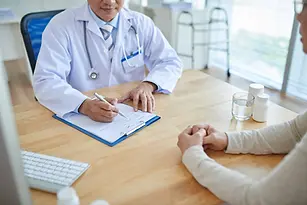
Acupuncture Services in Red Bank, NJ
Acupuncture in Red Bank, NJ
Schedule an appointment for acupuncture in Red Bank, NJ, by calling 732-530-7700.
Navesink Rehab is Red Bank’s acupuncture center with a caring staff to help give you relief from chronic or acute pain symptoms. Today, about 20 million Americans have tried acupuncture, according to Acupuncture Today. Acupuncture is a holistic treatment with overwhelmingly positive results for many patients.

What To Expect at an Acupuncture Appointment
Acupuncture works by restoring the flow of qi within the body to restore internal balance. Factors like chronic stress, illness, and lack of exercise can disrupt your qi, but your acupuncturist has the skill to identify problem areas and restore balance within your body.
Your acupuncturist will take the time to listen to your symptoms and ask pertinent questions to determine the best course of action, including supplemental methods like cupping or electrical stimulation. They will also determine the number of treatments you need in order to improve your overall well-being.
When treatment begins, the acupuncturist will carefully insert thin needles in specific areas to promote positive energy flow. Some patients expect needle insertion to feel painful but discover they were able to fall asleep during their appointment.
Benefits of Acupuncture in Red Bank, NJ
In patients with severe chronic pain, acupuncture has a 92% success rate, according to University Hospitals, which is higher than the 78% success rate of morphine, and doesn’t have the negative side effects that come with strong narcotics.
Acupuncture in Red Bank, NJ, treats a wide range of bodily pain, including obvious conditions like back pain and arthritis, but also less obvious conditions like TMJ pain and shingles.
Patients with chronic pain can finally get some relief without the burden of taking habit-forming drugs that create other problems within the body. Holistic treatments like acupuncture restore harmony in the body by reconnecting the mind and the body.
Acupuncture after a car accident can help relieve trauma from the accident. It can also relieve pain from whiplash, muscle spasms, and other minor injuries, according to PubMed.
Holistic Pain Relief in Red Bank
Acupuncture in Red Bank, NJ, can provide pain relief by restoring the flow of qi and helping the body and mind work in harmony. Acupuncture treatment often follows treatment from a chiropractor or massage therapist. To schedule an appointment with Navesink Rehab, fill out our online form or call 732-530-7700.
Our doctors accept most insurance plans, including workers’ compensation, no-fault, and PIP (personal injury protection). Same-day appointments may be available.

Acupuncture uses small needles placed at specific points to restore balance to the body and promote overall wellness. This traditional Chinese medicine has been around for centuries and has gained popularity in western medicine as a low-risk treatment option for several conditions. Acupuncture can be used on its own or in adjunct with other care options such as chiropractic care, physical therapy, and massage therapy.
Frequently Asked Questions
-
How long should you go to physical therapy after a car accident?Your treatment plan could last up to eight weeks after a car accident. The length of treatment depends on your physician and your specific circumstances.
-
Does physical therapy help with more than just pain?Pain reduction is what brings most people to physical therapy, but there are additional benefits. Dedicated physical therapy can increase mobility, decrease physical symptoms other than pain, and prevent additional injury in the future.
-
What are the disadvantages of physical therapy?There aren’t many disadvantages to physical therapy. Some patients don’t stick to their treatment plan because they expect to see immediate results, which leaves them with a bad opinion of physical therapy. Also, not all patients can afford multiple physical therapy visits due to being denied by their insurance provider or not having insurance at all.
-
When should you stop physical therapy?There is no set time for stopping physical therapy in Red Bank, NJ. You and your physician will set goals at the beginning of your treatment. Once you see those goals, you and your physician can decide if you are well enough to stop treatment.
ELECTRO-ACUPUNCTURE
Electro-Acupuncture is a fairly new technique compared to the legacy of traditional acupuncture. Electro-Acupuncture was originally developed to help broken bones heal quicker. Since then, Electro-Acupuncture has been shown to treat many conditions and is used by most traditional acupuncturists. The electric current added is able to expand the healing effects of needling and have been used to treat skin and neurological conditions.


GUA SHA
Gua Sha is a traditional Chinese therapy that is used to treat inflammation in the body. This technique involves scrapping your skin with varying strokes to increase micro circulation of the soft tissue. Gua Sha can be used on a person’s neck, back, arms, and legs. Gua Sha has been used to treat migraines, tourette’s, perimenopausals syndrome and chronic pain.
CUPPING THERAPY
Cupping therapy is an ancient technique dating back to 300 AD. In the 1950’s, cupping was established as an official therapeutic practice. Cupping involves placing suction cups on specific points of the body to relax the muscles and release toxins. Cupping is often used in conjunction with acupuncture and has recently become popular after star Michael Phelps boasted cupping as his recovery secret weapon.

